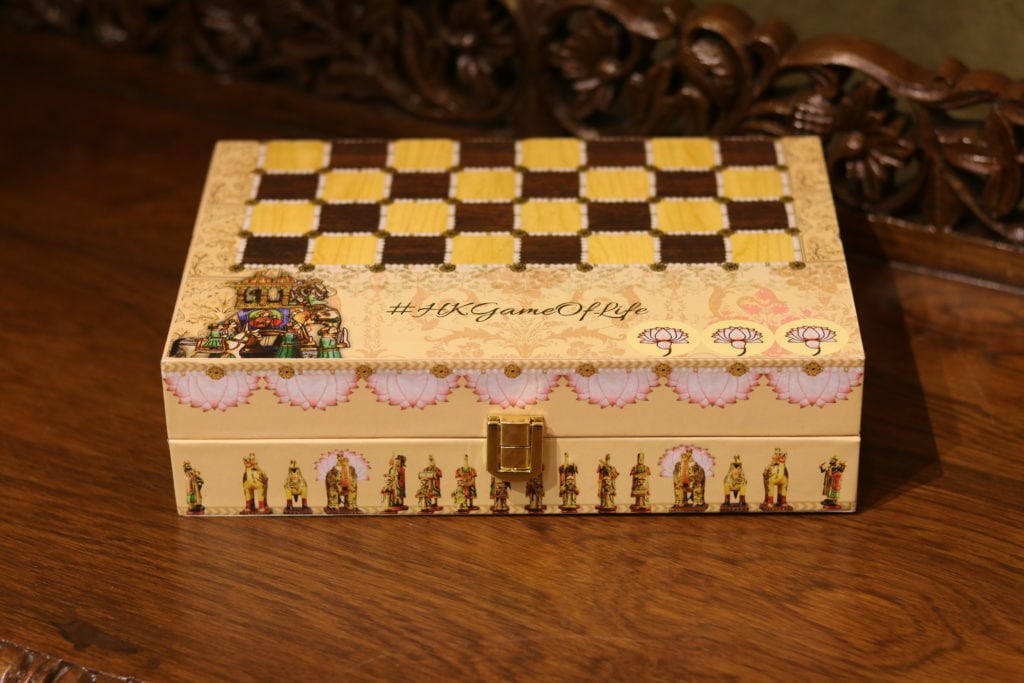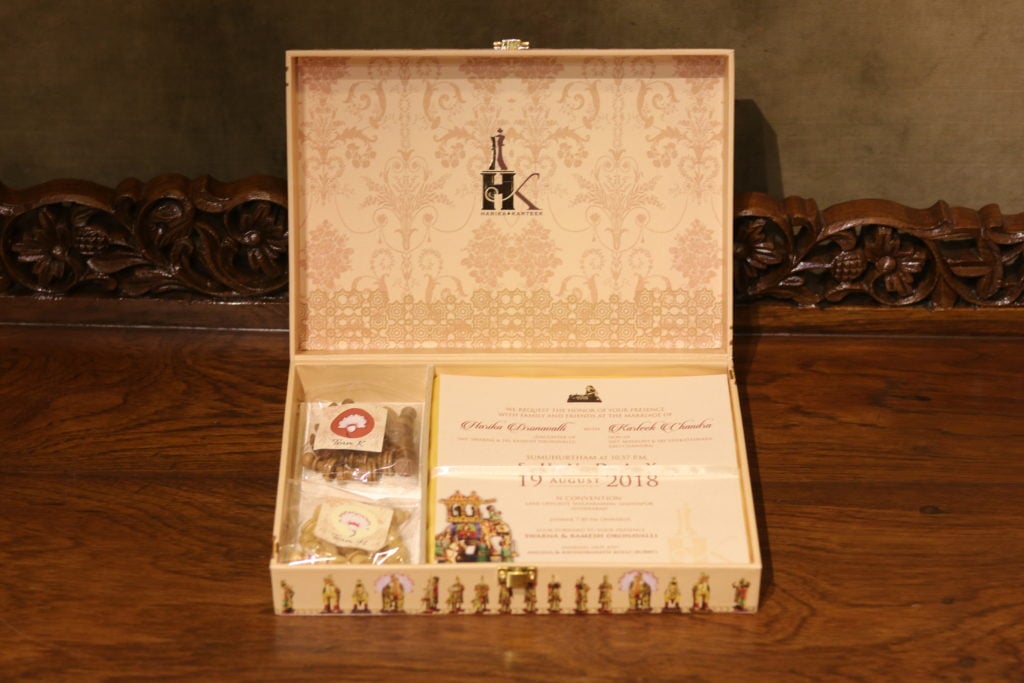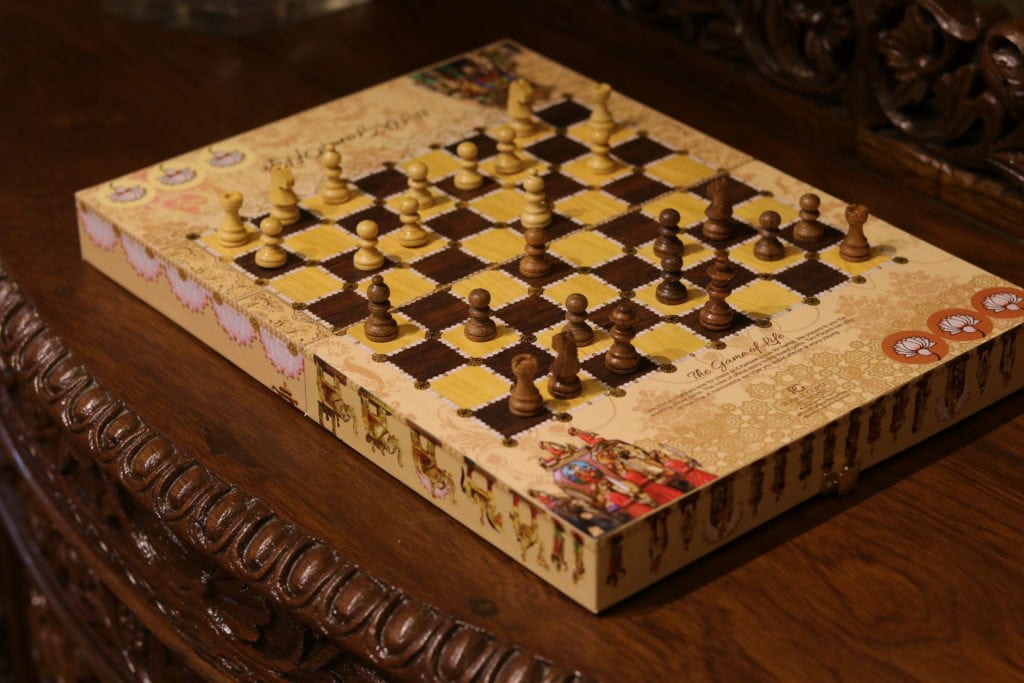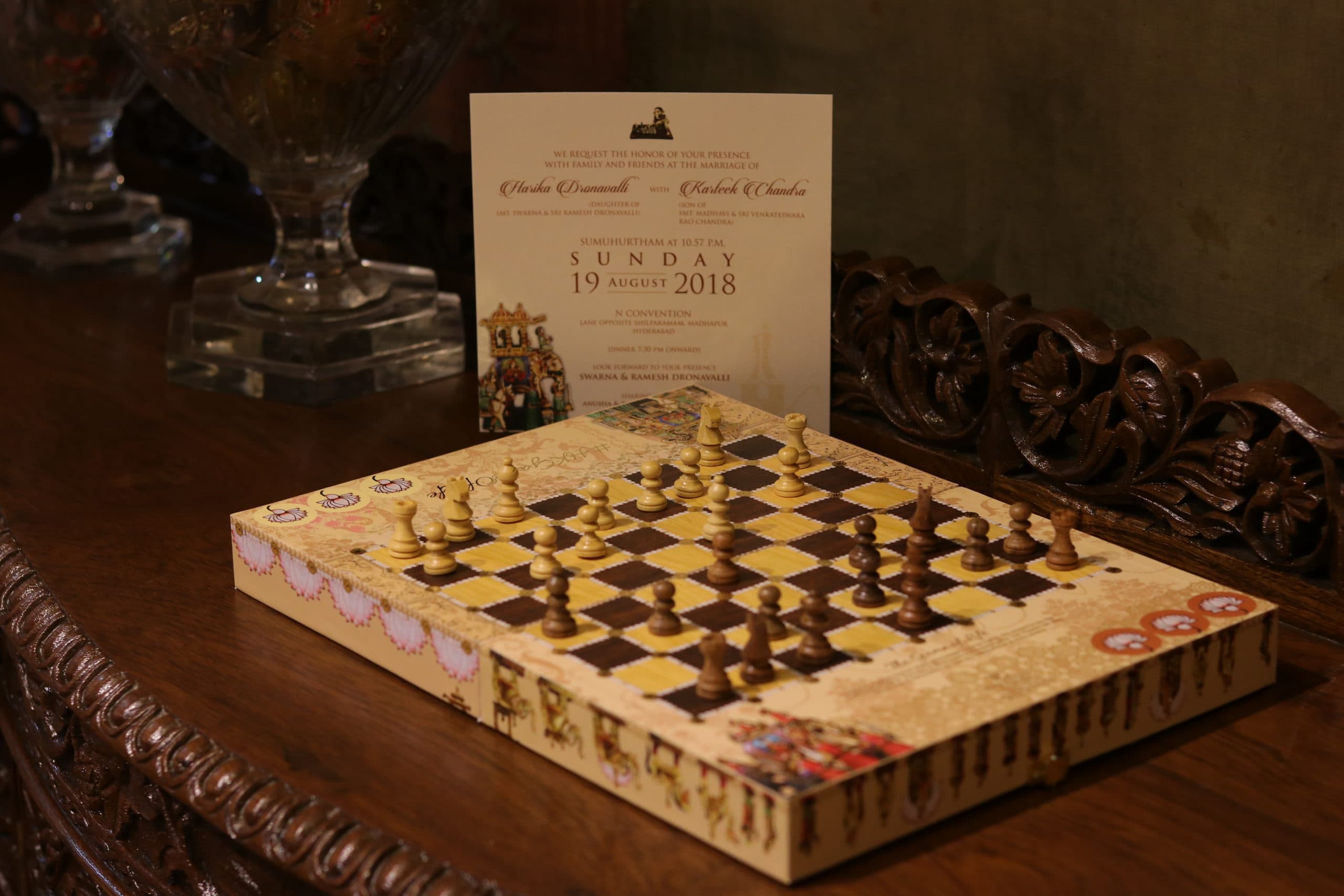Here comes the bride! Dedicating more than 18 years of her life to chess, Harika Dronavalli is better known as the Chess Grandmaster of India, a very unconventional bride so her invitation had to be unconventional too. Inspired by the oldest skill game of the world, the game of chess is a metaphor of life. The six different chess pieces on the board represent a cross section of medieval life with its many ceremonies, grandeur and wars.
We wanted to experiment with an amalgamation of her chess history with the parable analogy of the deep rooting thought “Chess is life in miniature.“ An inspiration for the Indian sportswomen, the invitation brings in the flavour of Harika’s drudgery and allegiance to the game.
A chess player is always better prepared to deal with the world. In this game of life you cannot just focus on your next move, but rather, you have to focus on your next three moves. The next move you make has an impact on the moves you’re allowed to and will be forced to make in the future. Every decision you make today will have an impact on your future decisions tomorrow, regardless of where you fit in this game of life.

Sometimes we make decisions fully believing that it was our best decision and ends up being the worst decision we could have made. What’s important though is how fast we are willing to get back up and start again. Each piece has to keep moving. Mistakes are made and learnt from. Such is the game of life. Thus we decided on the wedding hashtag as HK Game of Life!
Drifting away from the traditional invitation boxes and wedding favors, we wanted to create something that is completely reusable and reflects the personality of life. The concept was brought to life with chess being the common ground. With Indian royal chess piece motifs and prints outside, the invitation box opens up to be a little chess board that the guests can play on. With chess rules inscribed in brown, the guests have nothing to worry about even if they are playing the game for the first time. Instead of going for the classic names of the chess pieces, the dual coloured chess pieces were a reflection of ‘Team H’ (bride) and ‘Team K’ (groom). Along with the wedding chess game coined as #HKGameOfLife to the logo identity, each element of the invite beautifully portrays the horizon of ‘Traditional meets contemporary’.
Drawing graphical inspiration from ‘The Book of Games’ by Alponso X (King f Castile, Spain) , the invite is a salute to Alphonso X’s medieval literary legacy. The book is a treatise of how to play three board games: the game of skill (chess), the game of chance (dice) and the game of skill and chance (backgammon). Paradigm of Alfonso X’s cultural work, the 150 drawings in the Book of Chess, Dice and Board Games are one of the most important testimonies of his court paintings. Crafted on gold leaf and parchment, Manuscript (PG 22) from the book forms the main visual storyline for the invite.
Keeping in mind the durability factor, the invitation box has been designed as a wedding keepsake. The invite was crafted keeping in mind that when Harika’s guests first see the invite they are awestruck with amazement and instantly connect it to Harika without looking at the bride’s name. Therefore the invite not only acts as the first wedding communication between Harika and her guests but depicts her life story and her deep connection with chess. Welcome to the Game of Life!
Being a modern bride, we wanted Harika’s invite to be a reflection of her hard work and ambitious life whereas Harika’s parents believed in inviting guests in the traditional Indian way. Harika has represented India in various countries and wanted to send out something that is modern yet creative. We decided to work on two different designs catering to the different group of guests being invited by Harika and her parents. For Harika’s friends and close relatives we went for the chess theme wedding invitation and for her parents, we opted for a traditional and sober invitation design. In terms of design, both the invitations were opposite of each other yet had a faint similarity. The same modern logo and wedding hashtag were used in both the invites to create consistency and remembrance. The invitation box sent by Harika could be used a chess board with matching chess pieces sent out as favours. The one sent out by Harika’s parents was crafted on the lines of traditional outlook with a tint of modern touch like Ganesha playing chess.
Harika has dedicated 18 years of her life to chess, being crowned the chess grandmaster of India. She started playing chess when she was a child and decided to transform her passion into her dream. We were keen on playing around with this concept and wanted to bring in the flavour of Harika’s dedication to the game. To represent this thought process, we decided to convert the invitation box into a chess game board and instead of giving traditional sweets, chess pieces were incorporated as wedding favours. The invite has been crafted in such a manner that when the guests received the invites, they say-“Is this from Harika?” The chess themed invitation box is a parable analogy of Harika’s life and represent her most prized possession.
Chess is a miniature history of medieval times. It is further combined with 5 life-altering notions of Harika’s life depicted by each chess piece-

1. Sacrifice- The pawns on the chessboard teach us the innate quality of sacrificing. The pawns on the chessboard represent serfs, or labourers. There are more of them than any other piece on the board, and often they are sacrificed to save the more valuable pieces. Without the pawns, the higher powers would be weak, vulnerable. The pawn remains headstrong and looks ahead, knowing that if they work hard enough they will get rewarded and move well up the ladder. But there are times when a well-placed pawn is more powerful than the king. Harika sacrificed her favourite pastimes to focus on one goal-Chess.
2. Dedication- The knight on a chessboard represents the professional soldier of medieval times, whose job it was to protect persons of rank, and there are two of them per each side in a game of chess. Their purpose in the game of chess is to protect the more important pieces, and they can be sacrificed to save those pieces just as pawns can. They move around the world with their head and their heart. They are the motivators of the world. These are the pieces that encourage change. Starting at the age of 13, Harika has spent more hours practising chess than practising maths tables. She knows what it is to lose 100 games before winning your first ever chess game at the age of 14.
3. Patience-There is a bishop in the game of chess, who represents the church. The church was a rich and mighty force in medieval times, and religion played a large part in daily life. Just like every action taken in the name of God is for the betterment of the society, Harika patiently strategises her chess moves before every tournament. She is blessed with the rare gift of both, patience and strategic thinking which led her to learn much from her victory as well as defeats. She is known to ‘Win with grace and lose with dignity’.
4. Self-Confidence-The queen is the only piece on the board during a chess game that represents a woman, and she is the most powerful piece of the game, with unmatched freedom of movement. In chess, there is only one queen on each side. Many people do not realise that queens in medieval times often held a powerful, yet precarious, position. The king was often guided by her advice, and in many cases the queen played games of intrigue at court. Harika first travelled all alone for her chess tournament when she was a child. Her this bold step into the chess world goes a long way in crafting her confident personality. Ever since then she has not looked back and has honed her skills to be the best. Harika is the true queen of her life.
5. Support-The knight on a chessboard represents the professional soldier of medieval times, whose job is to protect persons of rank, and there are two of them per each side in a game of chess. Harika found her support in her family, friends and her soon-to-be-husband (now married) Kartik. They supported her in every endeavour she ventured on, whether she wanted to skip movies and stay in to practice chess or she just wanted some alone time to revise her chess moves. Just like the king supports her queen on the chess board, all the Kings of Harika’s life gave her time time to grow as a professional chess player and to evolve herself to be worthy of being the Chess Grandmaster of India.
Not every black and white invite looks as gracious as a gold embossed one. Our initial worry was as to how will we represent Harika’s rich life with mundane white and black chess board. Ever since our childhood, all of us have been taught to play on monotone hue chess boards but we were not keen on going ahead with this dull amalgamation of colours. We decided to went back in time and studied about the various advancements of chess ever since medieval times. Chess is believed to have developed in India, from a medieval game called Chatur-anga, or four-sectioned for the different divisions of the army, Kings and Queens on chariots, noblemen on elephants, cavalry and foot soldiers. Medieval Chess or Shatranj was initially played on an 8×8 board and featured 16 pieces on each side, similar to today’s chess: the soldier (pawn), the horse (knight), the elephant (a weaker bishop), the chariot (rook), the counselor (a much weaker queen), and the shah (king).
We decided to intertwine modern day chess and Harika’s life story with Indian Shatranj. After all, what better way to represent an international level champion if her cultural values are not involved.
Colour Palette
The modern world has changed the concept of professional chess with multi colour chess boards available in the market. From black to green, every colour can be customised as per requirement. But the history of chess dates back to medieval time when only light brown and dark brown hue chess boards were used. Black, white, green, blue, red etc. are the chess boards colours for friendly chess matches but for professional tournaments, the chess history is kept alive. Therefore we decided to proceed ahead with wood Brown, Gold and Beige as the colour storyline.
Logo

Inspired by the King and Queen of Chess a wedding insignia was designed around the initials of the bride and the groom with a crown formation with chess pieces on the head of alphabet H. The logo gives a very majestic and robust feel as their relation.
Graphical Identity
The chess invite has been handcrafted and hand-finished out of the finest Indian paper and wood board. It features a highly artistic design that has been influenced by the classical chess sets of India, with it’s slender proportions and imaginative design. Ornate hand carved chess pieces used in the erstwhile places of India have formed the inspiration for the design elements around the box.
The complimentary chess board has been designed to provide the perfect amount of contrast to differentiate the chess pieces of both the teams. The perimeter of the chess board features the traditional rank and file labels, and it can be folded in half for easy storage. Each wooden chess piece in this set is elaborately carved and painted in minute detail. The board box has a rich finishing touch with pearl print and gold highlights.
A cute highlight to the entire design was incorporating a Ganesha for the auspiciousness but with a twist. Gold Ganesha is shown in a leisure pose playing a game of chess quite literally!
Techniques
To accentuate the look of the wedding invite print techniques like Gold Foil Stamping and Heat Embossing have been used. Foil stamping is a special printing process that uses heat, pressure, metal dies and foil film and is used to add a touch of luxury to the designs. Heat Embossing adds a high shine factor and adds a super special touch – it can be used on its own to form a beautiful effect or combined with digital printing for an extra shine.
Materials
Chessboards have been made from numerous materials over the years, such as ebony, ivory, marble, metal and plastic. They have also been crafted out of glass and used as decorative pieces. We picked up this hint and decided to work with durable materials like wood, MDF, Imported French Paper to make sure the guests keep the chess themed wedding box as a memorabilia. Instead of opting for monotonous concept of sweets, chess pieces carved in wood were given as favours along with the wedding invite so the guests can indulge in a little game of chess even after the wedding festivities are over.
Harika Dronavalli says “Before coming to the studio, I didn’t know so much work goes behind an invitation. Thank you for all the wonderful invitations you did. I am glad I took this decision on my own and everyone appreciates me for this. “




